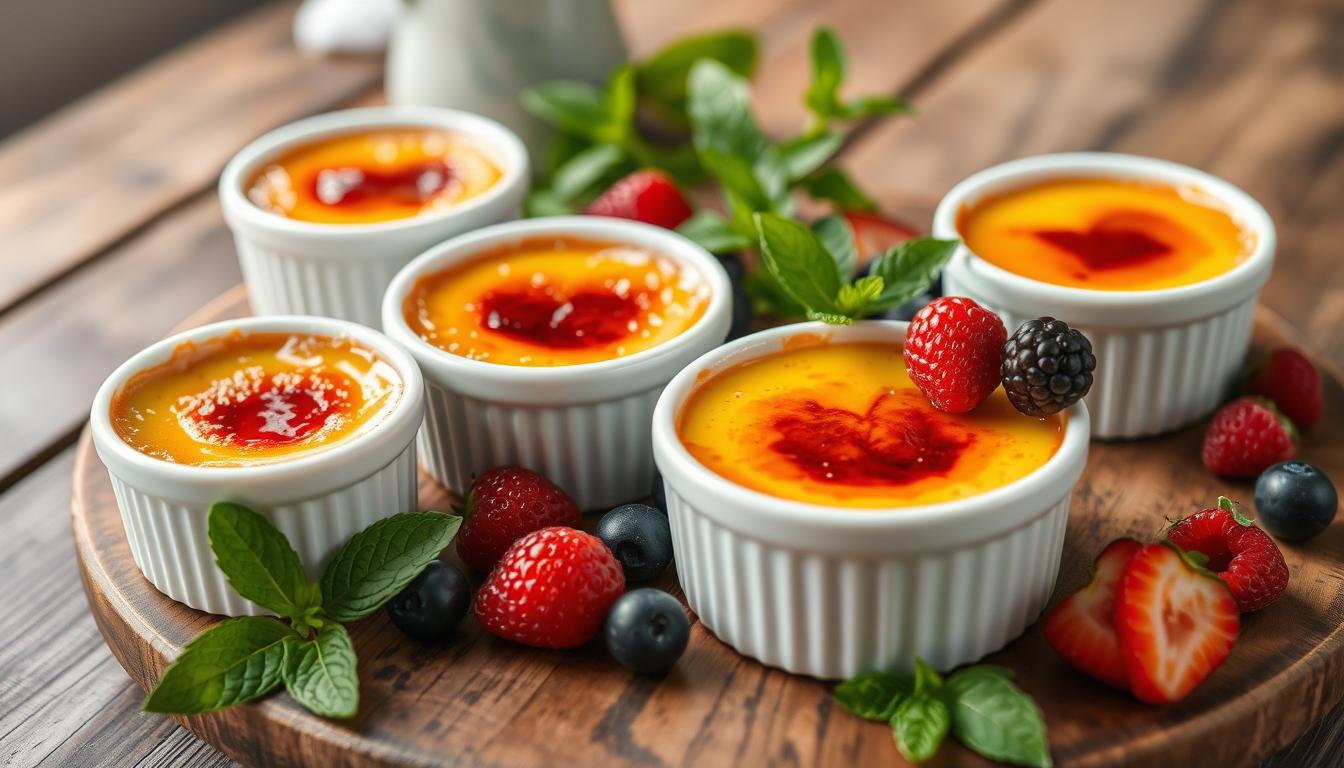French cuisine is full of treasures, but crème brûlée stands out. It’s a mix of smooth custard and a crunchy caramelized sugar top. When you touch it with a spoon, the sugar shatters.
This dessert comes from France’s fancy kitchens. It’s not just a sweet treat. It’s a challenge for both home cooks and chefs to get it right. The secret is in the balance between creamy custard and the crunchy sugar top.
Key Takeaways
- A classic French cuisine masterpiece that combines texture and flavor
- Requires precise temperature control and high-quality ingredients
- Features a unique contrast between creamy custard and crisp sugar top
- Ideal for impressing guests with minimal ingredients
- Offers a perfect blend of simplicity and elegance
Understanding the Classic French Dessert
Crème brûlée is a top pick in French cuisine, showing off the art of making desserts. It mixes old cooking traditions with a sensory delight that wins hearts around the world.
Origins of Crème Brûlée
The story of crème brûlée goes back centuries, rooted in European cooking. There’s a debate over who first made it, with French and English chefs both getting credit.
- First documented in the 17th century
- Originated in royal kitchens
- Became popular across European courts
The Perfect Balance of Textures
What sets crème brûlée apart is its amazing texture mix. It has a sublime interplay between smooth custard and a crunchy caramelized sugar top.
| Texture Component | Characteristics |
|---|---|
| Custard Base | Creamy, soft, delicate |
| Caramelized Top | Crisp, brittle, golden-brown |
Why It’s Called “Burnt Cream”
The name crème brûlée means “burnt cream” in French, because of the caramelizing process. When you break through the sugar top with a spoon, it’s a moment of culinary magic.
Crème brûlée is not just a dessert, it’s a performance on a plate.
Essential Ingredients for Perfect Crème Brûlée
Making a great crème brûlée needs careful attention and top-notch ingredients. Your baking skills are key to making this French classic a hit.
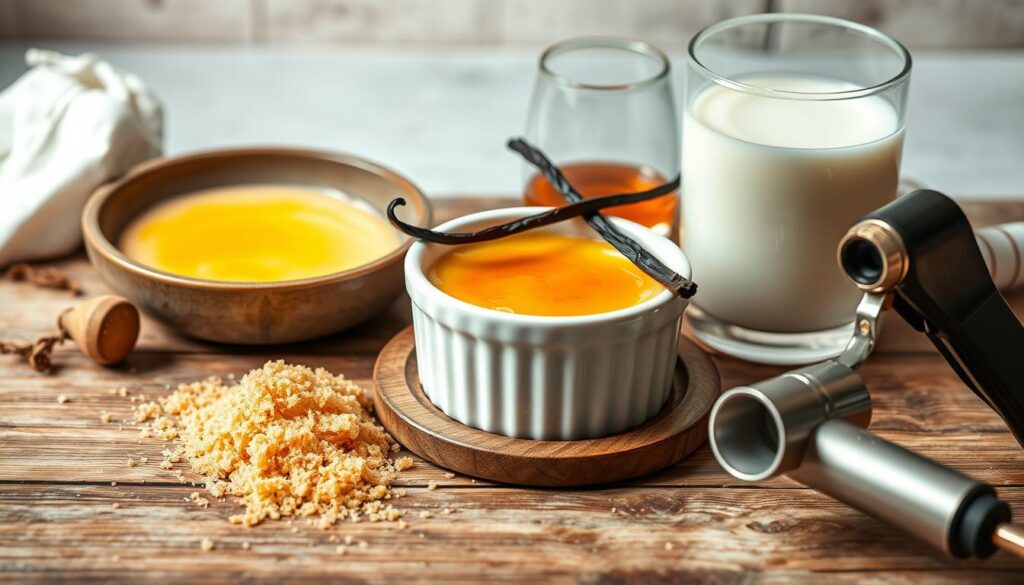
- Heavy cream (2 cups)
- Large egg yolks (5)
- Granulated sugar (1/3 cup for custard, 1/4 cup for topping)
- Pure vanilla extract (1 teaspoon)
- Pinch of coarse kosher salt
The magic of crème brûlée lies in its simplicity and ingredient quality.
Choosing the right ingredients can turn a simple dessert into a masterpiece. Go for fresh, high-fat heavy cream and real vanilla for the best taste.
| Ingredient | Quantity | Purpose |
|---|---|---|
| Heavy Cream | 2 cups | Creates rich, smooth texture |
| Egg Yolks | 5 large | Provides custard structure |
| Sugar | 1/2 cup total | Sweetness and caramelization |
Experts say to use turbinado sugar for the best caramelized top. This method gives a crunchy, golden layer that breaks nicely with a spoon tap.
The Science Behind Temperature Control
Mastering crème brûlée needs precision in baking and temperature control. Success comes from knowing the right heat and cooking method. This turns simple ingredients into a luxurious dessert.
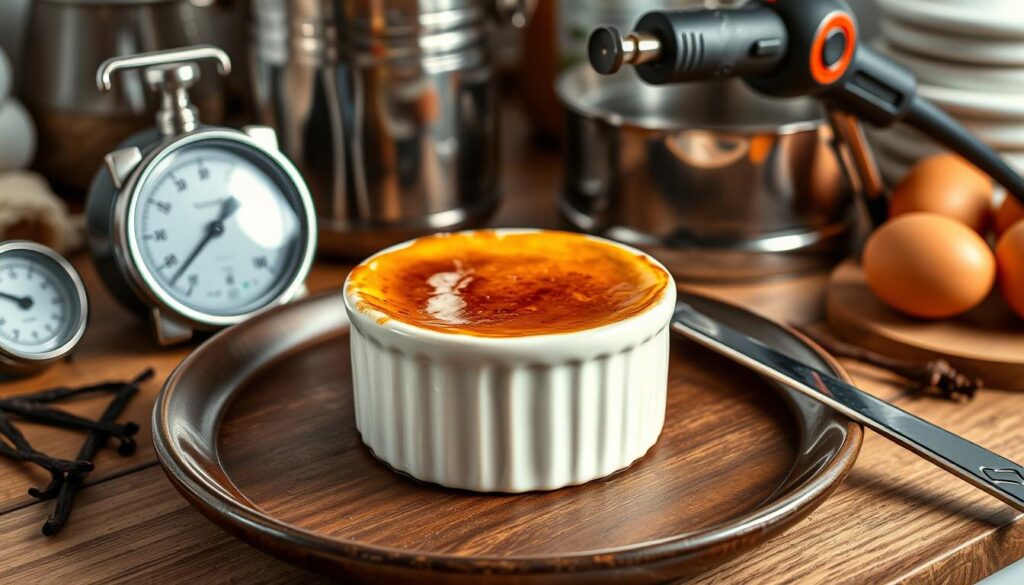
Water Bath: The Secret to Perfect Custard
The water bath, or bain-marie, is key for a silky custard. It cooks the mixture gently, avoiding curdling. By using warm water, you get even heat and keep the custard smooth.
- Water should reach halfway up ramekin sides
- Maintains consistent low temperature
- Prevents edge overcooking
Ideal Baking Temperature Explained
Temperature control is vital for perfect crème brûlée. Baking at 325°F (160°C) for 35-45 minutes is recommended. This slow cooking keeps the custard smooth.
| Temperature Range | Cooking Duration | Custard Result |
|---|---|---|
| 325°F (160°C) | 35-45 minutes | Smooth, creamy texture |
| Below 300°F | Longer cooking time | Potential undercooking |
| Above 350°F | Shorter cooking time | Risk of curdling |
Temperature Monitoring Pro Tips
Use a reliable instant-read thermometer to check the custard’s temperature. Aim for 170-175°F (77-79°C). This ensures it’s cooked right, without becoming scrambled.
Precision is the soul of the perfect crème brûlée.
What is the secret of crème brûlée?
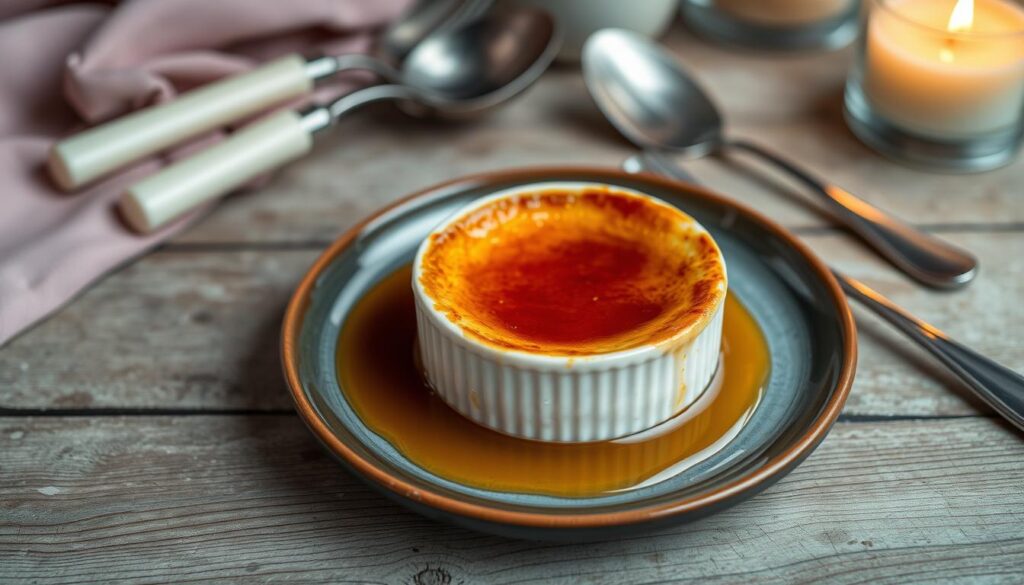
To make the perfect crème brûlée, you need to master a few key techniques. These steps turn this classic dessert into something truly special. You’ll learn how to make a silky base and a caramelized sugar topping that cracks with a spoon tap.
Here are the secrets to making crème brûlée like a pro:
- Using high-quality ingredients at precise temperatures
- Achieving a custard consistency similar to thick Greek yogurt
- Creating a thin, crisp caramelized sugar topping
- Maintaining exact baking temperatures
Temperature control is key. Your custard should bake at 325°F (160°C) for 40-45 minutes. This ensures it wobbles slightly in the center. The water bath helps distribute heat evenly, keeping the custard creamy.
The perfect crème brûlée is a dance of precision between cream, eggs, and heat.
To make the caramelized sugar topping, sprinkle ½ cup of sugar evenly. Then, use a kitchen torch for controlled movements. Aim for a golden-brown layer that’s thin and crisp, not burnt. It takes practice to get it right!
A great crème brûlée balances smooth custard with a crackling caramelized sugar topping. With practice, you’ll make a dessert that looks amazing and tastes incredible.
Mastering the Custard Base
Making the perfect custard dessert needs precision and knowing how to bake carefully. The key to a great crème brûlée is its creamy custard base. This base needs careful making and attention to detail.
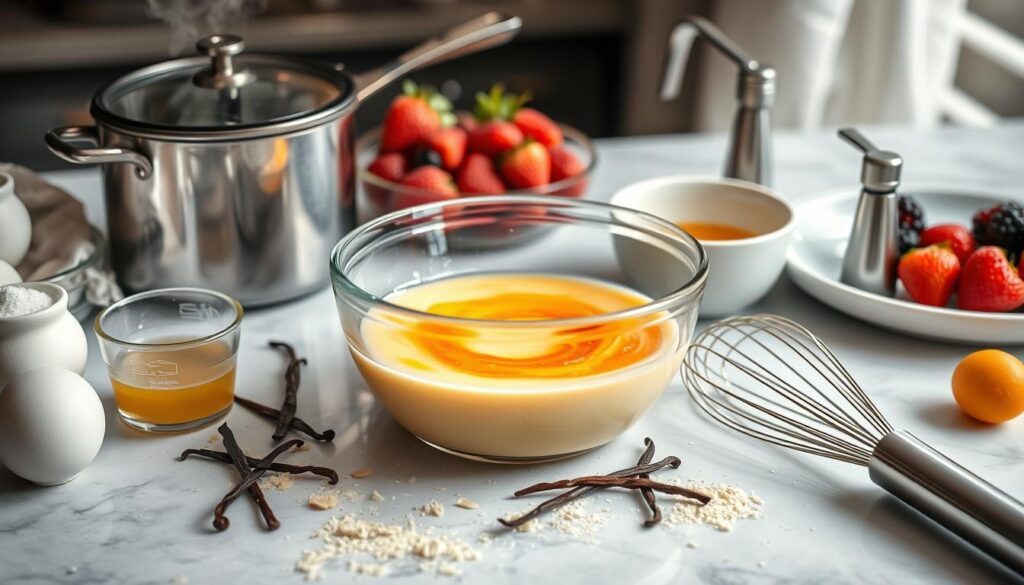
Success with your custard base comes from several important steps. These steps turn simple ingredients into a rich dessert. Let’s look at the key techniques that make your crème brûlée stand out.
Proper Egg Mixture Technique
Starting with egg yolks is key to a great custard. Here’s how to do it right:
- Choose fresh, room-temperature egg yolks
- Whisk yolks with sugar until they’re pale and creamy
- Whisk gently to avoid air bubbles
- Go for a light, ribbon-like texture
Cream Infusion Methods
Adding flavor to your cream is important. Your baking should include:
- Heat cream slowly with vanilla bean
- Steep for 15-20 minutes
- Strain to remove vanilla bean pieces
Straining for Smoothness
Straining is the last step to a smooth custard. Use a fine-mesh sieve to get rid of lumps. This ensures a silky texture.
Perfection is in the details of your custard preparation.
| Ingredient | Quantity | Purpose |
|---|---|---|
| Egg Yolks | 4-5 | Create rich, creamy base |
| Double Cream | 420 ml | Provide luxurious texture |
| Caster Sugar | 70 g | Sweeten and stabilize custard |
Mastering the custard base is an art. It combines precise technique with patient preparation. Your hard work will make a memorable crème brûlée.
The Art of Caramelization
Turning your crème brûlée into a masterpiece starts with the caramelized sugar topping. This key step needs precision and skill. It creates the golden-brown layer that makes the dessert special.
Choosing the right sugar is the first step to success. Superfine sugar is best for even caramelization. Spread a thin, even layer over the chilled custard for complete coverage.
The magic of crème brûlée lies in that perfect moment when your spoon cracks through the caramelized sugar layer.
Caramelization Techniques
- Use a kitchen torch for precise control
- Move the flame in circular motions
- Aim for a deep golden-brown color
- Watch carefully to prevent burning
Experts say a culinary torch that gets hot enough is key. It should reach about 2,500°F. This lets you get that perfect caramelized sugar topping. The trick is to move it constantly to avoid burning.
Pro Tips for Perfect Caramelization
- Chill custard thoroughly before caramelizing
- Use turbinado sugar for enhanced flavor
- Caramelize just before serving
- Aim for a thin, crisp layer that cracks when tapped
Timing is everything in caramelizing. Do it just before you serve. This keeps the sugar crisp and makes the dessert unforgettable.
Common Mistakes to Avoid
Making the perfect custard dessert needs care and focus. Even skilled bakers face issues with this classic French treat. Knowing common mistakes helps you make a flawless crème brûlée that looks and tastes great.
Preventing Overcooking
This custard dessert is very delicate. Overcooking can ruin it, making it grainy and unpleasant. Here’s how to avoid it:
- Use a water bath to distribute heat evenly
- Monitor internal temperature carefully
- Bake between 325°F to 350°F
- Remove when center has a slight jiggle
Selecting the Right Sugar
The right sugar is key for the caramelized top. Not all sugars work well in crème brûlée.
| Sugar Type | Caramelization Performance |
|---|---|
| Granulated Sugar | Excellent, creates crisp top |
| Turbinado Sugar | Good alternative with deeper flavor |
| Powdered Sugar | Avoid – does not caramelize well |
Smart Storage Guidelines
Storing your custard right keeps its texture perfect. Pro tip: Always chill uncaramelized custards. Torch the sugar just before serving.
Perfection in crème brûlée is about precision and patience.
- Refrigerate custards up to 3 days
- Blot surface moisture before caramelizing
- Caramelize sugar immediately before serving
- Use about 1 tablespoon sugar per ramekin
Professional Tools and Equipment
Making a restaurant dessert like crème brûlée needs special baking skills and tools. Professional chefs know that the right tools make a big difference. They can turn a good dessert into an amazing one.
Here are the key tools for making perfect crème brûlée:
- Ceramic Ramekins: 6-8 ounce sizes for ideal heat distribution
- Kitchen Torch: Provides precise sugar caramelization
- Instant-Read Thermometer: Ensures perfect custard temperature
- Fine-Mesh Strainer: Creates silky smooth texture
Your kitchen torch is key for that perfect caramel top. Chefs say using a torch is better than a broiler. It gives you more control over caramelizing the sugar.
The right tools transform a simple dessert into a culinary masterpiece.
There are more tools that can help with your crème brûlée:
- Vanilla Bean Knife: For precise pod scraping
- Roasting Pan: Creates perfect water bath environment
- Digital Kitchen Scale: Ensures precise ingredient measurements
Buying quality tools will make a big difference in your baking. It will help you make desserts as good as those in restaurants, right in your kitchen.
Make-Ahead Tips and Storage
Planning ahead can make your custard dessert easy and fun. Preparing crème brûlée early lets you enjoy more time with guests. You won’t be stuck in the kitchen all day.
Proper Cooling Techniques
After baking your custard, follow these cooling steps:
- Let custards cool to room temperature naturally
- Avoid sudden temperature changes to prevent cracking
- Use a wire rack for even cooling
Refrigeration Guidelines
Storing your crème brûlée right keeps it smooth:
- Cover ramekins tightly with plastic wrap
- Refrigerate for up to 3 days before serving
- Keep the fridge at a steady temperature
Serving Temperature Recommendations
For the best dining experience, remember these tips:
- Take custards out of the fridge 30 minutes before serving
- Caramelize sugar topping just before serving
- Serve within 2 hours of caramelizing
The secret to a perfect crème brûlée is in its preparation and timing.
By following these tips, your custard dessert will stay creamy and look great.
Creative Variations and Garnishes
Make your French custard dessert stand out with new flavors and beautiful looks. The classic crème brûlée is a canvas for your creativity.
Try exciting flavors to turn this French classic into a gourmet treat:
- Chocolate espresso crème brûlée
- Lavender-infused custard
- Citrus zest variation
- Matcha green tea crème brûlée
- Seasonal fruit-inspired versions
Think about how you’ll garnish it. These touches can make a big difference:
- Fresh berries arranged delicately
- Mint leaves for a pop of color
- Edible flower petals
- Candied citrus peels
- Chocolate shavings
The magic of crème brûlée lies in its ability to surprise and delight with every creative twist.
For a fancy touch, try making sugar cages. Drizzle caramelized sugar over an oiled ladle. This garnish will make your dessert look like a work of art.
| Flavor Variation | Key Ingredient | Complexity Level |
|---|---|---|
| Classic Vanilla | Pure Vanilla Bean | Beginner |
| Espresso | Finely Ground Coffee | Intermediate |
| Lavender | Dried Lavender Buds | Advanced |
| Matcha | High-Quality Green Tea Powder | Expert |
Remember, trying new flavors and garnishes is all about creativity. Don’t be afraid to let your culinary creativity shine!
For more dessert inspiration, check out our delightful Crab Brûlée Recipe. It’s a savory twist on the classic brûlée, showcasing the versatility of this iconic caramelized topping technique!
Conclusion
Learning the secret of crème brûlée takes patience and precision. It’s all about balancing flavors and textures. With practice, you can turn a simple dessert into a culinary masterpiece.
The secret to success is mastering temperature and technique. Achieving the right custard and caramelizing sugar are key. Many home chefs use a culinary torch for that perfect caramel crust.
Creating crème brûlée is more than just a dessert. It’s a chance to dive into French cooking traditions and learn about ingredients. Each ramekin is a chance to create something special.a
With dedication and the skills you’ve gained, you can make a dessert that’s not just delicious but also tells a story. Your homemade crème brûlée will show off your growing skills and love for great desserts.

